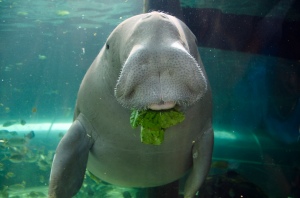For years I have been working with animals and always tried to explain to questioning family and friends the fact that there is so much more to looking after animals than the obvious cleaning up after them. Well, now even that is much more interesting than you would think. Sydney Aquarium is lucky enough to be home to 2 adult Dugongs, Pig our male and Wuru our female. Being shy and elusive animals in the wild has meant that dugongs are a very difficult species to study. As a result, easier and less invasive methods have had to be developed to tell us what is happening with these animals.
There is very little information on the wild reproductive behaviour of dugongs and the little information collected over the years has only ever given a snapshot of one animal at one moment in time. Just like in humans, male and female dugongs produce the same hormones, particularly testosterone, oestrogen and progesterone. These hormones change depending on whether the animal is mature, immature, going through a reproductive cycle or pregnant. Adding to the list we also have corticosterone or cortisol, a stress hormone that can also be measured in most animals. These hormones and their changes show up very quickly in blood samples but getting blood from a Dugong is not the easiest thing to do. So how do you monitor breeding cycles in Dugongs? Put quite simply….you collect their poo.
During our regular cleaning dives, divers are on the lookout for a Dugong swimming past taking a nice dump. They have to be quick as some of the fish seem to enjoy the digested lettuce, the main diet of our Dugongs, and getting a fresh sample and knowing who it came from is important. The faeces and dried, bagged, labelled and frozen. Once we have enough bags or there has been some unusual changes in feeding or behaviour between the two Dugongs, we send the samples off to be tested. The samples are dried in an oven (perhaps not the same one you cook your dinner in) and the dry, powdered poo is tested to measure the levels of the different hormones in each sample.
The only thing we need to keep in mind is that a Dugongs digestive system is slow, taking about a week for their food to pass from one end to the other. This also means that the different hormones and the changes will also take longer to show up in the faecal samples than what they would in a blood sample. If the results come back and show a sudden spike in oestrogen in Wuru on a particular date, we need to then look at what happened a week earlier and try to match up any changes we see in feeding, behaviour or interaction between the two Dugongs to the start of her breeding cycle.
Being able to measure hormone levels in the Aquarium’s dugongs over many years, has meant we now have a wide range of hormone levels for a male and female, starting from juveniles, right through to sexually mature animals. Once we can put all of our feeding and behavioural observations together with the actual hormone changes, we can start to predict breeding cycles, know when there will be sudden drops in feeding and know when Pig might be a little more aggressive than usual. Being a species that is rarely kept in captivity (only 6 animals on display around the world) and with so little information known about them, most of what we are experiencing with our animals is providing new information about this fascinating species. This information can then be applied to behavioural studies of wild populations of Dugongs, enhancing the little information about reproductive behaviour that exists, and potentially aiding in conservation efforts, as Dugong numbers are in decline worldwide.
Andrew 🙂


Leave a comment